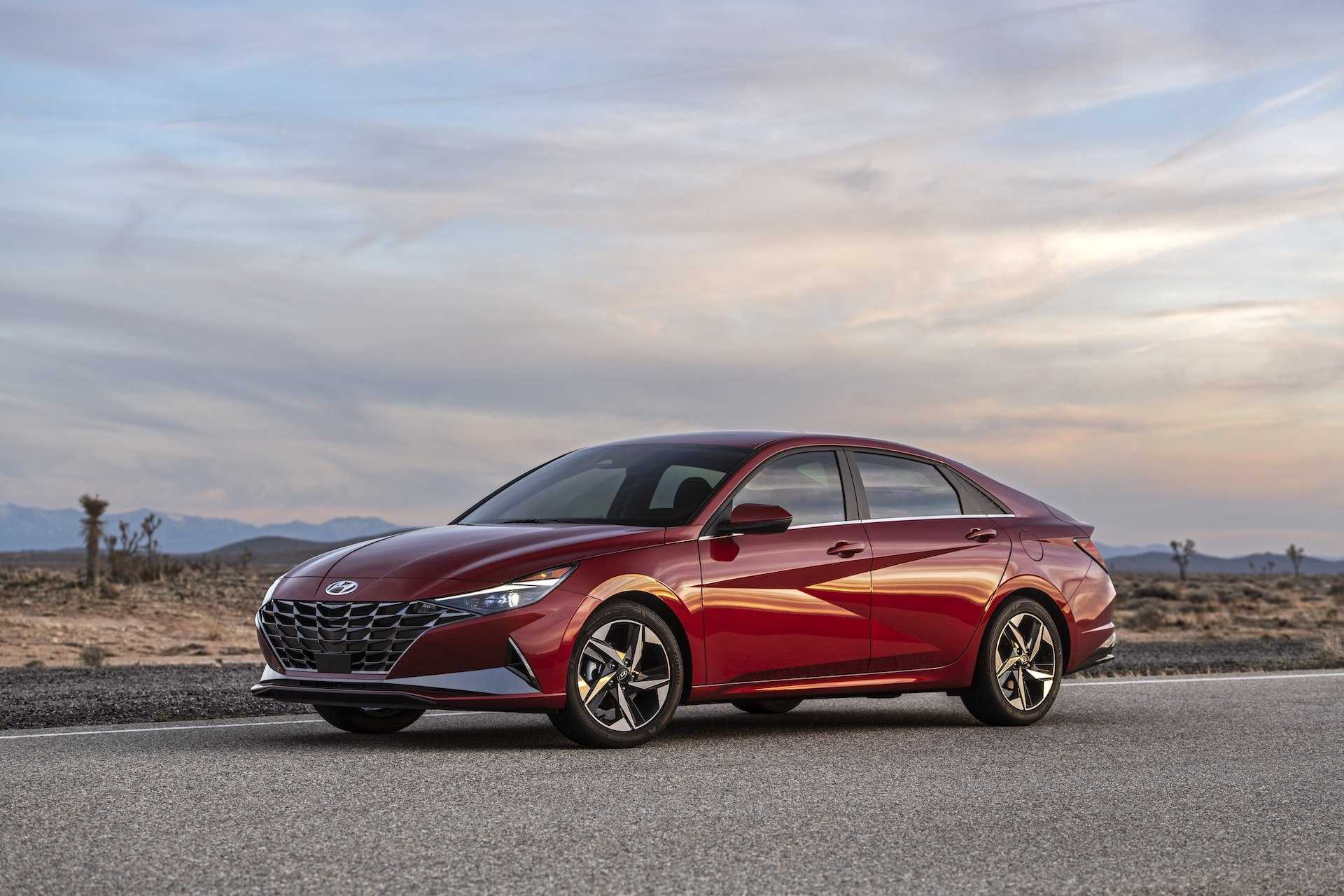Hyundai Elantra 2023 Drive Mode Integrated Control System
With the 2023 Hyundai Elantra Drive Control System and Driving Conditions Guidelines, welcome to the world of customized driving experiences and improved control. This thorough handbook will be your reliable travel companion as you take off with this cutting-edge sedan, illuminating the Drive Control System’s dynamic capabilities and adaptability to a range of driving situations. Hyundai’s dedication to provide a secure and adaptable driving experience is evident in everything from knowing which driving modes maximize performance to becoming an expert in the vehicle’s responsiveness in various weather and terrain situations. These recommendations enable you to fully utilize the capabilities of your 2023 Elantra, whether you’re looking for sportiness, efficiency, or stability. This makes sure that every drive is not only pleasurable but also customized to your preferences and the route ahead.
2023 Hyundai Elantra Specs, Price, Features, Milage (Brochure)
Drive Mode Integrated Control System
Drive Mode

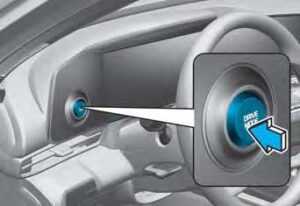
The Hyundai Elantra drive mode may be selected according to the driver’s preference or road condition.
Information
If there is a problem with the instrument cluster, the drive mode will be in COMFORT mode and may not change to NORMAL mode or SPORT mode.
Hyundai ElantraDRIVE MODE button.
COMFORT mode provides smooth driving and comfortable riding.
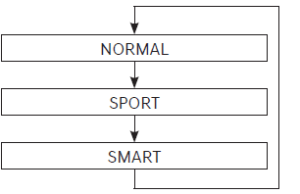
When NORMAL mode is selected, it is not displayed on the instrument cluster.
- NORMAL mode :
NORMAL mode provides smooth driving and comfortable riding. - SPORT mode :
SPORT mode provides sporty but firm riding
The drive mode will change to NORMAL mode when the engine is restarted. However, except when it is in Elantra SMART mode.
SMART mode Hyundai Elantra will be maintained, as selected when the engine is restarted.
If you change the setting of the drive mode integrated control mode, the SCC reaction of Smart Cruise Control is also changed. (if equipped)
| Drive mode integrated control mode |
SCC reaction |
| NORMAL | Normal |
| SPORT | Fast |
| SMART | Normal |
Hyundai Elantra SPORT mode
SPORT mode manages the driving dynamics by automatically adjusting the steering effort, the engine, and the transmission control logic for enhanced driver performance.
- When SPORT mode is selected by using the DRIVE MODE button, the SPORT indicator will illuminate.
- Whenever the engine is restarted, the Drive Mode will revert back to NORMAL mode. If SPORT mode is desired, re-select SPORT mode from the DRIVE MODE button.
- When SPORT mode is activated:
- The engine rpm will tend to remain raised over a certain length of time even after releasing the accelerator
- Upshifts are delayed when accelerating
Information
In SPORT mode, the fuel efficiency may decrease.
Hyundai Elantra Smart Mode
SMART mode selects the proper driving mode among ECO, NORMAL, and SPORT by judging the driver’s driving habits (for example, Economic or Aggressive (Sportive) from the brake pedal depression or the steering wheel operation.
- Toggle the DRIVE MODE button to select SMART mode. When SMART mode is selected, the indicator illuminates on the instrument cluster.
- SMART mode automatically controls the vehicle driving, such as gear shifting patterns and engine torque, in accordance with the driver’s driving habits.
- Whenever the engine is restarted, the drive mode remains in SMART mode.
Information
- When you mildly drive the vehicle in SMART mode, the driving mode changes to SMART ECO mode to improve fuel efficiency. However, the actual fuel efficiency may differ in accordance with your driving situations (for example, upward/downward slope, vehicle deceleration/acceleration).
- When you dynamically drive the vehicle in SMART mode by abruptly decelerating or sharply turning the driving mode changes to SMART SPORT mode. However, it may adversely affect fuel economy.
Various driving situations, which you may encounter in SMART mode
- The driving mode automatically changes to SMART ECO mode after a certain period of time, when you gently depress the accelerator pedal (Your driving is categorized to be economic.).
- The driving mode automatically changes from SMART ECO mode to SMART NORMAL mode after a certain period of time, when you sharply or repetitively depress the accelerator pedal.
- The driving mode automatically changes to SMART NORMAL mode with the same driving patterns, when the vehicle starts to drive on an upward slope of a certain angle. The driving mode automatically returns to SMART ECO mode, when the vehicle enters a leveled road.
- The driving mode automatically changes to SMART SPORT, when you abruptly accelerate the vehicle or repetitively operate the steering wheel (Your driving is categorized to be sporty.). In this mode, your vehicle drives in a lower gear for abrupt accelerating/decelerating and increases the engine brake performance.
- You may still sense the engine braking performance, even when you release the accelerator pedal in SMART SPORT mode. It is because your vehicle remains in lower gear over a certain period of time for the next acceleration. Thus, it is a normal driving situation, not indicating any malfunction.
- The driving mode automatically changes to SMART SPORT mode only in harsh driving situations. In most of the normal driving situations, the driving mode is set to be either in SMART ECO mode or in SMART NORMAL mode.
Limitation of SMART mode
The SMART mode may be limited in the following situations. (The OFF indicator illuminates in those situations.)
- The cruise control is activated: The cruise control system may deactivate the SMART mode when the vehicle is controlled by the set speed of Smart Cruise Control system. (SMART mode is not deactivated just by activating the cruise control system.)
- The transmission oil temperature is either extremely low or extremely high :
The SMART mode can be active in most of the normal driving situations. However, an extremely high/ low transmission oil temperature may temporarily deactivate the SMART mode, because the transmission condition is out of normal operation condition.
Smart Shift On Trip Computer (if equipped)
Select the Trip Computer mode ( ) on the instrument cluster LCD display and move to the smart shift screen. Then, the driver can see the drive mode selected and the drive mode which is automatically switched by the SMART mode.
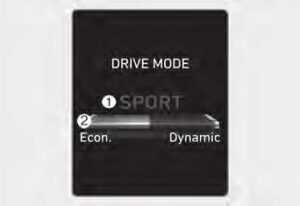
The drive mode selected by the driver (1) and the driving style gauge (2) showing the driver’s driving style are displayed on the screen.
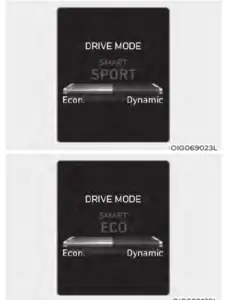
With the standard driving style in the center, the left side of the gauge is ‘Econ.’ and the right side is ‘Dynamic’ style.
When the left side of the driver’s style gauge is filled up and after a certain time passes, the SMART ECO mode is activated automatically. When the right side of the gauge is filled up and sporty driving condition is detected, the SMART SPORT mode is activated. To maintain the SMART ECO mode for fuel efficiency, drive with the left side of the gauge filled up.
Special Driving Conditions
Hazardous Driving Conditions
When hazardous driving elements are encountered such as water, snow, ice, mud, and sand, take the below suggestions:
- Drive cautiously and keep a longer braking distance.
- Avoid abrupt braking or steering.
- When your vehicle is stuck in snow, mud, or sand, use second gear. Accelerate slowly to avoid unnecessary wheel spin.
- Put sand, rock salt, tire chains or other non-slip materials under the wheels to provide additional traction while the vehicle becomes stuck in ice, snow, or mud.
WARNING
Downshifting with an intelligent variable transmission while driving on slippery surfaces can cause an accident. The sudden change in tire speed could cause the tires to skid. Be careful when downshifting on slippery surfaces.
Rocking the Vehicle
If it is necessary to rock the vehicle to free it from snow, sand, or mud, first turn the steering wheel right and left to clear the area around your front wheels. Then, shift back and forth between R (Reverse) and forward gear. Try to avoid spinning the wheels, and do not race the engine. To prevent transmission wear, wait until the wheels stop spinning before shifting gears. Release the accelerator pedal while shifting, and press lightly on the accelerator pedal while the transmission is in gear. Slowly spinning the wheels in forward and reverse directions causes a rocking motion that may free the vehicle.
WARNING
If the vehicle is stuck and excessive wheel spin occurs, the temperature of the tires can increase very quickly. If the tires become damaged, a tire blowout or tire explosion can occur. This condition is dangerous – you and others may be injured. Do not attempt this procedure if people or objects are anywhere near the vehicle.
If you attempt to free the vehicle, the vehicle can overheat quickly, possibly causing an engine compartment fire or other damage. Try to avoid spinning the wheels as much as possible to prevent overheating of either the tires or the engine. DO NOT allow the vehicle to spin the wheels above 35 mph (56 km/h).
2023 Hyundai Elantra Specs, Price, Features, Milage (Brochure)
Information
The ESC system must be turned OFF before rocking the vehicle.
NOTICE
If you are still stuck after rocking the vehicle a few times, have the vehicle pulled out by a tow vehicle to avoid engine overheating, possible damage to the transmission, and tire damage. See “Towing” in chapter 7.
Smooth Cornering
Avoid braking or gear changing in corners, especially when roads are wet. Ideally, corners should always be taken under gentle acceleration.
Driving at Night
Night driving presents more hazards than driving in the daylight. Here are some important tips to remember:
- Slow down and keep more distance between you and other vehicles, as it may be more difficult to see at night, especially in areas where there may not be any street lights.
- Adjust your mirrors to reduce the glare from other driver’s headlights.
- Keep your headlights clean and properly aimed. Dirty or improperly aimed headlights will make it much more difficult to see at night.
- Avoid staring directly at the headlights of oncoming vehicles. You could be temporarily blinded, and it will take several seconds for your eyes to readjust to the darkness.
Driving in the Rain
Rain and wet roads can make driving dangerous. Here are a few things to consider when driving in the rain or on slick pavement:
- Slow down and allow extra following distance. Heavy rainfall makes
it harder to see and increases the distance needed to stop your vehicle. - distance. A heavy rainfall makes
it harder to see and increases the distance needed to stop your vehicle. when they show signs of streaking or missing areas on the windshield. - Tires should be properly maintained with at least 2/32nds of an inch of tread depth. If your tires do not have enough tread, making a quick stop on wet pavement can cause a skid and possibly lead to an accident. See “Tire Tread” in chapter 8.
- Turn on your headlights to make it
easier for others to see you. - Driving too fast through large puddles can affect your brakes. If you must go through puddles, try to drive through them slowly.
- If you believe your brakes may be wet, apply them lightly while driving until normal braking operation returns.
Hydroplaning
If the road is wet enough and you are going fast enough, your vehicle may have little or no contact with the road surface and actually ride on the water. The best advice is to SLOW DOWN when the road is wet. The risk of hydroplaning increases as the depth of tire tread decreases, refer to “Tire Tread” in chapter 8.
Driving in Flooded Areas
Avoid driving through flooded areas unless you are sure the water is no higher than the bottom of the wheel hub. Drive through any water slowly. Allow adequate stopping distance because brake performance may be reduced. After driving through water, dry the brakes by gently applying them several times while the vehicle is moving slowly.
Highway Driving
Tires
Adjust the tire inflation, as specified. Under-inflation may overheat or damage the tires. Do not install worn-out or damaged tires, which may reduce traction or adversely affect vehicle handling. This could lead to sudden tire failure that may cause loss of vehicle control resulting in an accident.
Information
Never over-inflate your tires above the maximum inflation pressure, as specified on your tires.
Fuel, engine coolant and engine oil
Driving at higher speeds on the highway consumes more fuel and is less efficient than driving at a slower, more moderate speed. Maintain a moderate speed in order to conserve fuel when driving on the highway.
Be sure to check both the engine coolant level and the engine oil before driving.
Drive belt
A loose or damaged drive belt may overheat the engine.
FAQ
The Drive Control System typically allows you to choose between different driving modes to optimize performance and efficiency.
The User Guide should explain the available driving modes (e.g., Eco, Sport, Normal) and how they adjust factors like throttle response, steering, and transmission behavior.
The User Guide should provide instructions on how to switch between driving modes.
Some vehicles allow customization of driving mode settings. The User Guide may provide details on how to adjust these settings.
The User Guide may offer tips and recommendations for driving safely in various weather conditions, such as rain, snow, or extreme heat.
The User Guide may provide guidance on adapting your driving style and using specific driving modes for off-road or rough terrain.
The User Guide may provide tips on navigating steep grades and descents in hilly or mountainous terrain.
The User Guide may offer suggestions for optimizing your driving experience in heavy traffic, such as using adaptive cruise control or stop-and-go assistance features.
The User Guide may provide driving tips and recommendations for achieving better fuel economy with specific driving modes.
Some vehicles may have safety features like stability control or traction control that are affected by driving modes. The User Guide may explain these features.
The User Guide should outline any specific maintenance requirements or recommendations related to the Drive Control System.
The User Guide may provide information on practices and habits that help prolong the lifespan of the Drive Control System components.
The User Guide may include troubleshooting tips for common issues related to the Drive Control System and when to seek service.
The User Guide may explain how to reset the Drive Control System to its default settings if you’ve customized them and wish to return to the factory settings.
The User Guide may provide information on any limitations or precautions, such as not using certain driving modes in specific conditions.
What does smart mode do on Hyundai Elantra?
The “Smart” mode in a Hyundai Elantra is a driving mode that automatically adapts to your driving style, optimizing fuel efficiency and performance by switching between Eco, Comfort, and Sport modes as needed, providing a balance between economy and responsiveness.
Useful Link
View Full User Guide: Hyundai Elantra 2023 User Guide
Download Manuals: https://owners.hyundaiusa.com/us/en/resources/manuals-warranties.html
2023 Hyundai Elantra Specs, Price, Features, Milage (Brochure)

